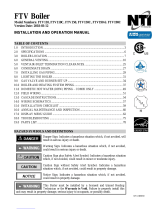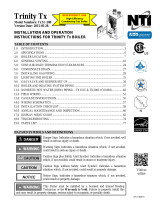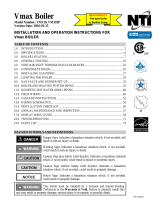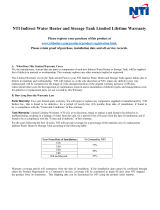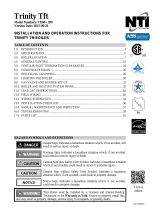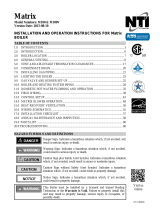
6
Part 2. Gas valve and burner setup
2. Gas Line pressure
The boiler gas valve is equipped with a Line
Pressure Test Port; see screw 1, Figure 5.
Use the following procedure to measure the
gas line pressure to the boiler to ensure it falls
within the range given in Table 2:
a. Turn the supply of gas to the boiler off.
b. Loosen screw 1 (Torx 10 - Line Pressure
Test Port). This port is directly connected
to the gas line feeding the boiler. See
screw 1, Figure 5.
c. Connect a gas pressure gauge to the line
pressure test port using applicable tubing.
Ensure both ends of the tubing make a
tight connection.
d. Turn the gas supply to the boiler on and
check for gas leaks.
e. Observe the line pressure under static
conditions and compare it to Table 2.
The pressure will be greatest under static
conditions.
f. Observe the line pressure with the boiler
running, while checking/adjusting the
CO2 at maximum and minimum gas flow
rate (see Part. 3).
Compare it to Table 2. The pressure will be
lowest during the maximum flow of gas.
1. Operating Sequence
Prior to commencing the Gas Valve and
Burner Setup, perform the following
operating sequence check:
a. Turn the supply of gas to the boiler off.
b. Set the thermostat to the highest setting.
c. Ensure the combustion fan prepurges for
a short time prior to activating the igniter.
d. Ensure the combustion fan postpurges for
at least 5 seconds prior to reactivating the
igniter.
e. Set the thermostat to the lowest setting
and continue with the Gas Valve and
Burner Setup procedure outlined below.
Failure to perform the Gas Valve
and Burner Setup correctly may
result in incorrect operation,
component failure, property
damage, serious injury or death.
Table 2 - Line Pressure Parameters
Line Pressure
(inches w.c.)
Nominal Min. Max.
Natural 7 3.5 10.5
Propane 11 8 13
Failure to close the bleed screw
of the Line Pressure Test Port will
cause a severe leakage of gas,
resulting in a fire or explosion
causing property damage, serious
injury or death.
g. Adjust the gas line pressure to ensure the
parameters in Table 2 are attained under
all conditions.
If possible, adjust the line pressure to
the “Nominal/Desired” value listed in
Table 2 while the unit is operating at the
maximum power.
Continue observing gas line pressure
until completing of necessary Checking/
Adjusting of the CO2 (see Part 3), in case
adjustments need to be made.
h. Complete pressure testing. Remove the
tubing from the test port and then return
the bleed screw of the Line Pressure Test
Port to the closed position.
Check for gas leaks.
WARNING
DANGER
The line pressure is a function
of the gas supply and is affected
solely by field provided parameters
such as line size and regulator
settings. Under no circumstances
can the boiler gas valve influence
or be used to adjust the gas line
pressure.
NOTICE












